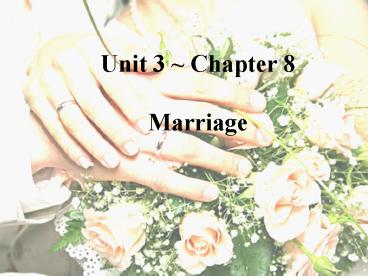Unit 3 ~ Chapter 8 - PowerPoint PPT Presentation
1 / 16
Title:
Unit 3 ~ Chapter 8
Description:
(Eqypt & N. Africa) Other kingdoms, including European royalty, also have practiced endogamy, but based on cousin marriage rather than sibling marriage. This ... – PowerPoint PPT presentation
Number of Views:132
Avg rating:3.0/5.0
Title: Unit 3 ~ Chapter 8
1
Unit 3 Chapter 8 Marriage
2
What is marriage?
No definition of marriage is broad enough to
apply easily to all societies and situations
therefore, we start with this commonly quoted
definition by the
Royal Anthropological Institute Marriage is a
union between a man and a woman such that the
children born to the woman are recognized as
legitimate offspring of both partners.
3
- This definition isnt universally valid for
several reasons, among them are - In many societies, marriages unite more than two
spouses (plural marriages). - Some societies recognize various kinds of
same- sex marriages.
4
Plural Marriage
Most non-industrial food producing societies
allow plural marriage, or polygamy. There are two
forms of polygamy Polygyny - where a man has
more than one wife. Polyandry - where a woman
has more than one husband.
5
- Polygyny
- Most common form of plural marriage.
- In some societies, men marry when they are older
(18-30), while women marry between 12-14.
When the women naturally outlive their
husbands, they join other polygynous unions as
widows. - The number of wives can indicate a mans social
status. - Plural wives can play political roles, as
representatives of different clans, provinces,
etc. - For this to work, there has to be an
understanding among the existing spouses.
6
- Polyandry
- Very rare, mostly occurs in South Asia - Tibet,
Nepal, India, and Sri Lanka. - Sometimes this is due to a shortage of females.
- Sometimes the polyandry is fraternal (a female
marries all brothers in a family). - Polyandry restricts the number of wives and
heirs. This is effective in a society where
resources are scarce.
7
- Same Sex Marriages
- By and large illegal in the United States.
(Legal in England, Scotland, Ireland, Wales,
and some other European countries.) - Other societies allow same sex marriages as a
necessity to preserve a familys patrilineage.
(See next slide for example.)
8
Example In Sudan, a Nuer woman can marry a woman
if her father has only daughters, but no son to
carry on the familys name. The daughter becomes
the socially recognized husband of another
woman. It is a symbolic relationship rather than
a sexual one. The wife has sex with a man or
men, whom the female husband approves of, until
she gets pregnant. The child is accepted as the
offspring of both the female husband and the
wife. Although the female husband is not the
actual genitor (the biological father of the
children), she is the pater, or socially
recognized father. Therefore, the paternal
descent line is continued.
9
- Why do we marry?
- In many non-industrialized societies, there
are two types of people strangers and kin. - Marriage is one of the primary ways to convert
strangers into family. - Therefore, exogamy (the practice of seeking a
spouse outside of ones group) is often
necessary.
10
- Exogamy
- Links people to a wider social network
- By forcing members to marry out, a group
increases its allies. - In many cultures, marriage alliances can be
maintained between groups even when one spouse
dies
Sororate - if a wife dies, the
husband marries her sister Levirate - a
widow marries the brother of her deceased
husband
11
- The opposite of Exogamy is Endogamy
- Endogamy - marrying a person from within your
own group. - Examples include
Indias Caste System - must marry
within your social class Royal incest
(including brother and sister) - only a sibling
has the royal mana and is therefore the only
appropriate wife for a king. (Eqypt N.
Africa) Other kingdoms, including European
royalty, also have practiced endogamy, but based
on cousin marriage rather than sibling
marriage. This also ensured that - royal wealth remained in the same family
lineage.
12
In the United States, we see marriage as an
individual decision, predicated upon romantic
love.
Outside of industrialized societies, marriage is
often a relationship between groups, rather than
individuals.
13
Descent groups often assist with marriage by
contributing the the bridewealth, a customary
gift before, at, or after the marriage from the
husband and his kin to the wife and her kin.
A bridewealth compensates the brides group for
the loss of her companionship and labor.
Moreover, it makes the children born to the woman
full members of the husbands descent group.
14
The opposite of a bridewealth is a dowry, which
is money or substantial gifts provided from the
wifes family to the husbands family.
A dowry correlates with low female status. Women
are perceived as burdens. When husbands and their
families take a wife, they expect to be
compensated for the added responsibility (best
known from India.)
15
Divorce
- Ease of divorce varies among cultures
- Marriages that are political alliances between
groups are harder to break up than marriages that
are more individual affairs. - Payments of bridewealth also discourage divorce.
- Divorce is more common in countries where women
have more rights. - Divorce is harder in patrilocal societies as the
woman may be less inclined to leave her children.
16
Divorce in the United States
- The U.S. has one of the worlds highest divorce
rates. - The U.S. has a very large percentage of
gainfully employed women. - Americans value independence.
- NOTE Polygamy is illegal in America, but
Americans do practice serial monogamy, through
multiple marriages and divorces.































